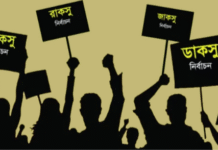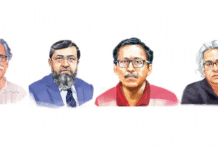
Some of the Savar collapse survivors admitted to the National Institute of Traumatology & Orthopaedic Rehabilitation (Nitor) yesterday.
Rikta Moni suddenly attempts to sit up on her bed, forgetting that a fracture in her spinal cord and several wounds in her body will not let her do so. Groaning in acute pain, she starts screaming, “Sister, get me out of here. The building is crumbling down!”
The building was not falling down. She just heard a very low sound of thunder. Neither was there Asha Begum, her elder sister whom a shuddering Rikta was calling out as she lay in a bed at Dhaka Medical College Hospital on Sunday evening.
Eighteen-year-old Rikta was a sewing machine operator working on the third floor of Rana Plaza that caved in last week. Aasha, a quality controller on the same floor, is yet to be found.
“Any minor sound can cause panic among this type of victims so much that they may start to hallucinate in any situation,” Muntasir Maruf, assistant registrar of National Institute of Mental Health, has told The Daily Star.
Haunting memories, “intrusive thought” in medical terms, traumatised victims like Rikta, who had been trapped 24 hours in the wreckage of the nine-storey building, are a cue to hallucination and fear.
Facing the risk of complex and permanent health hazards, many victims of the collapse will become physically and mentally disabled in the long run, said doctors.
“Those who were hurt in different parts of their bodies, even if there is no sign of cut or fracture in bones, will develop various problems like paralysis, urinal problems due to the fall of heavy objects like a pillar,” said Prof Amjad Hossain, former head of Ortho and Trauma Surgery Department of DMCH.
A crushed muscle can cause bleeding inside the body. This blood, once clotted, will travel to the lung, causing major lung problems, he said.
And those who bled too much may have renal failures.
A number of patients at ward No 206 of DMCH, like Rehana, 20, whose thighs were crushed by a pillar while working on her floor, have been urinating by alternative means.
“Several of these patients are already suffering from renal failure,” said Haridas Saha, a resident surgeon of DMCH.
Those like Rikta Moni who suffered injuries in the head and spinal cord have the risk to be long-term sufferer, according to Haridas Saha. Bleeding inside the head may cause paralysis of either the right or the left side of the body, he added.
“Many of the victims whose limbs remained trapped for a long time also face the risk of becoming paralysed,” said Dr Asadullah Ripon, assistant professor at Enam Medical College and Hospital, on Sunday. He had treated the victims both at the site and in the hospital.
Amena Begum, a 35-year-old sewing machine helper on the third floor, haunted by her three-day stay under the rubble surrounded by bodies of dead colleagues, insists on not staying under a concrete roof as a building took away her daughter Elina, a 17-year-old helper who is still missing.
“She [Elina] is calling me every now and then, telling me not to live in any concrete-walled room,” wailed the mother at a medicine ward of DMCH.
Depression, loss of temperament and enthusiasm for work, sleep disorder and panicking in any minor incident are among a few symptoms the trauma victims can develop, said Maruf.
Others, including victims’ relatives, rescuers, witnesses and even journalists may develop post-traumatic stress disorder symptoms, he added.
Source: The Daily Star









